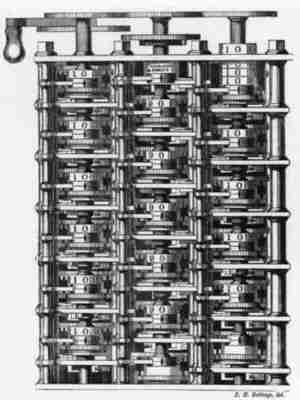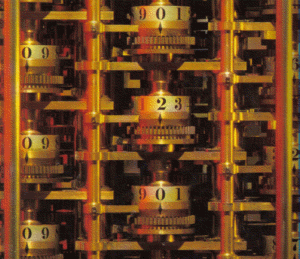 SKC Films Library SKC Films Library |
| SKC Films Library >> Science >> Mathematics >> Instruments and Machines |
| Difference Engine the first known mechanical computer Before the widespread availability of dependable mechanical, and, later, electronic calculators, scientists, astronomers, navigators, actuaries, bankers, etc. relied for the most part on printed mathematical tables to perform calculations requiring more than a few figures of accuracy. The repetitive calculations for these tables were performed by hand by people called "computers" and results were then copied and set in loose type for printing. Mistakes were common. Charles Babbage, an English mathematician and inventor, sought to build an automatic calculating machine that would eliminate all these sources of inaccuracy. It was his belief that the "unerring certainty of mechanism" would free calculation of human error, and having the machine print the results automatically would eliminate the risk of mistakes in manual transcription and typesetting, and it was this belief that led him to design the Difference Engine. The Difference Engine was conceived to calculate and automatically print error-free mathematical tables. It is so named because of the mathematical principle upon which it is based, the method of finite differences. The advantage of the method is that it allows complex mathematical expressions to be calculated using simple addition only, without the need for multiplication and division which would ordinarily be required. Babbage began working on Difference Engine No. 1 in the early 1820's, but the machine was never completed. The project was abandoned in 1833 after a dispute with the engineer, Joseph Clement, who had been engaged to build the machine. About one-seventh of the engine had been assembled as a demonstration piece by Clement in 1832, and this portion of the engine is the first known automatic calculator. It is automatic in the sense that for the first time mathematical rule was incorporated directly into the mechanism -- the operator did not need to understand the mechanical or logical principles to achieve useful (and accurate) results. All that was required was to turn the handle and the machine did the rest. woodcut diagram of a portion of Babbage's
Differential Engine a close-up of the mechanism -- on display at the
Science Museum, London The Difference Engine is capable of a fixed set of operations determined by its wheel work. Babbage's Analytical Engine, however, conceived in 1834, has features that are amazingly similar to those of a modern electronic computer. The Analytical Engine was programmable using punched cards, had a repertoire of basic operations (multiplication, division, addition and subtraction), and could automatically execute sequences of these operations in any order. The "mill," where information was processed, was physically separate from the "store" or memory where information was kept. The separation of "store" and "mill" (today called the central processor) is a feature that has dominated the design of the electronic computer since the mid-1940's. Designs for the Analytical Engine were highly developed, but no Analytical Machine was ever actually built. SOURCE SEE ALSO |
| SKC Films Library
>> Science >> Mathematics >> Instruments and Machines This page was last updated on 06/23/2017. |

